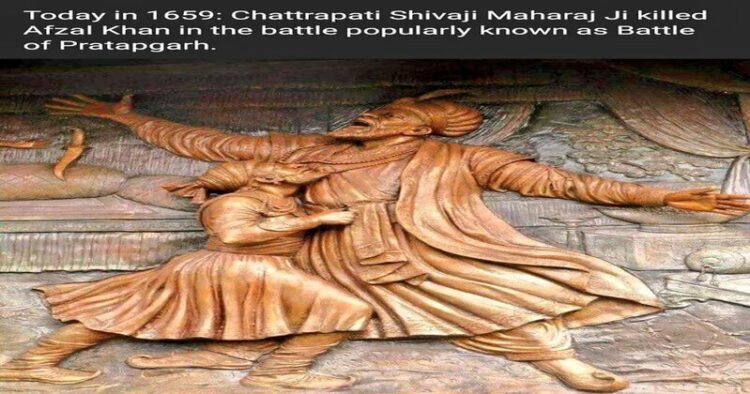Sudhir Mungantiwar, Maharashtra, Minister for Cultural Affairs (amongst other charges) will visit London later this month to sign a Memorandum of Understanding with the Victoria and Albert Museum after the UK authorities agreed to return the tiger claws – an indigenous (Indian) weapon called ‘Wagh Nakh’ used by Chhatrapati Shivaji Maharaj in the year 1659 to kill Afzal Khan the marauder who was an army general of the Bijapur sultanate.
https://twitter.com/SMungantiwar/status/1700080742204887275/photo/1
History of India took a defining turn at the foothills of the Pratapgarh fort of Maharashtra when Shivaji Maharaj beat the conniving attacker at his own game and clawed his guts out.
The Wagh Nakh is a dagger that is shaped like tiger claws — made of metal fashioned in the shape of 4-5 hooked blades attached to a crossbar strip or glove that can be worn stealthily like rings. This famous Maratha weapon is designed to slash through skin and muscle. The design of the Wagh Nakh is believed to have been inspired by the armature of big cats (especially the tiger that has concealed and retractable or drawable at will claws), and the term ‘Bagh Nakh’ itself means Tiger’s claw in Hindi.

Sudhir Mungantiwar has tweeted a video in which he stated that his team (led by him) will visit London to sign an MoU on 3rd October as there are conditions laid out by the British museum authorities. The Wagh Nakha will finally arrive in India in November.
छत्रपती शिवाजी महाराजांची ऐतिहासिक वाघनखं ब्रिटनमधून भारतात आणली जाणार, लवकरच दोन्ही देशांमध्ये करार – सांस्कृतिक कार्यमंत्री@SMungantiwar यांची माहिती. #ShivajiMaharaj #TigerClaw #Maharashtra @DDNewslive @DDNewsHindi pic.twitter.com/aCbXb6Devm
— DD Sahyadri News | सह्याद्री बातम्या (@ddsahyadrinews) September 8, 2023
Currently, the Wagh Nakh or Bagh Nakh (Marathi: वाघनख) of the Maratha warrior king who established the Hindawi Swarajya is in London at the Victoria and Albert Museum (https://collections.vam.ac.uk/item/O134202/tiger-claws-unknown/). The museum archives state that it is claimed that this is the same piece that was used by Shivaji Maharaj when six-and-a-half-feet tall Afzal Khan feigning friendship held the Maratha king in an embrace and tried stabbing him in the back.
Since the said claws belong to Chhatrapati Shivaji Raje Bhonsle a.k.a Shivaji Maharaj and hold extremely high historical and cultural significance.
During a protracted military engagement in 1659, Afzal Khan (armed with a huge army and loads of ammunition) tried hard to draw Shivaji Maharaj out onto the plains for confrontation. But the Maratha warrior who had perfected his guerilla tactics succeeded in getting the Bijapur warlord to agree to meet for a truce in a tented enclosure, virtually alone. Both were to carry no swords but the Khan breached his promise exactly as suspected and tried stabbing the Maratha warrior king in the back.
Shivaji Maharaj survived due to the concealed armour he wore under his clothes and a metal skull protection under his turban. With his Wagh Nakh, Shivaji Maharaj disembowelled the treacherous Afzal Khan.
The claws are accompanied by a fitted case that is inscribed: “The ‘Wagnuck’ of Sivajee With Which He Killed the Adilshahi Army’s General. This Relic was given to Mr. James Grant-Duff of Eden When he was Resident at Satara By the Prime Minister or the Peshwa of the Marathas”. The Peshwa that the British records state here is Baji Rao II (grandson of the iconic Baji Rao Peshwa) who surrendered to the British in June 1818 after defeat in the Third Anglo-Maratha War and was exiled to Bithoor near Kanpur.
The wagh nakh is being handed over by the British authorities to India under conditions pertaining to its security and protection. The British authorities have refused to agree to the Wagh Nakh being taken across Maharashtra as a heritage item. They insist that the museum piece be held safely at one safe museum where all can come and see it from a distance.



















Comments